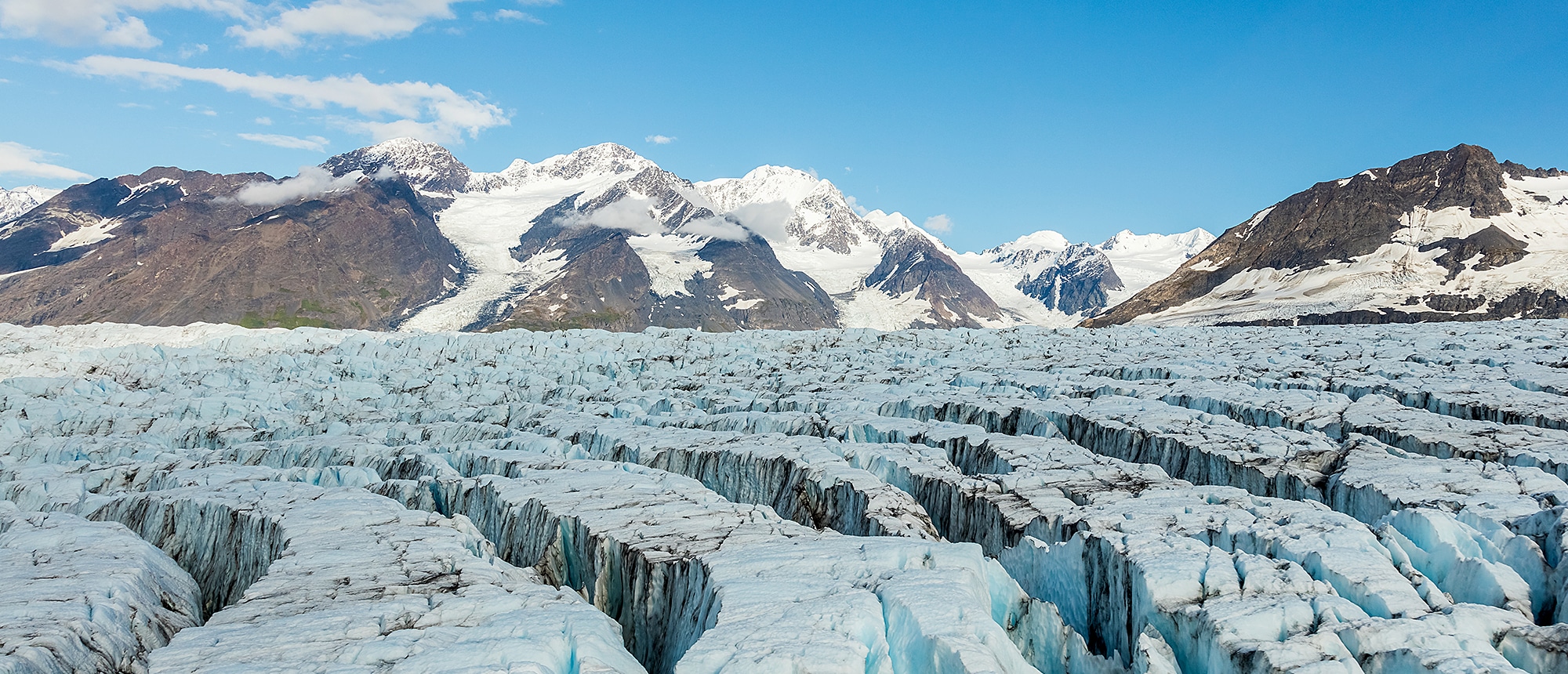Alaska’s National Climate Assessment
Alaska has warmed twice as fast as the rest of the nation, bringing widespread impacts. Sea ice is rapidly receding and glaciers are shrinking. Thawing permafrost is leading to more wildfire, and affecting infrastructure and wildlife habitat. Rising ocean temperatures and acidification will alter valuable marine fisheries.
Introduction
The Alaska region includes the state of Alaska and its surrounding waters. The Highlights section below offers a high-level overview of climate change impacts on this region, including the five Key Messages and selected topics.
Key Message: Disappearing Sea Ice
Arctic summer sea ice is receding faster than previously projected and is expected to virtually disappear before mid-century. This is altering marine ecosystems and leading to greater ship access, offshore development opportunity, and increased community vulnerability to coastal erosion.
Key Message: Shrinking Glaciers
Most glaciers in Alaska and British Columbia are shrinking substantially. This trend is expected to continue and has implications for hydropower production, ocean circulation patterns, fisheries, and global sea level rise.
Key Message: Thawing Permafrost
Permafrost temperatures in Alaska are rising, a thawing trend that is expected to continue, causing multiple vulnerabilities through drier landscapes, more wildfire, altered wildlife habitat, increased cost of maintaining infrastructure, and the release of heat-trapping gases that increase climate warming.
Key Message: Changing Ocean Temperatures and Chemistry
Current and projected increases in Alaska’s ocean temperatures and changes in ocean chemistry are expected to alter the distribution and productivity of Alaska’s marine fisheries, which lead the U.S. in commercial value.
Key Message: Native Communities
The cumulative effects of climate change in Alaska strongly affect Native communities, which are highly vulnerable to these rapid changes but have a deep cultural history of adapting to change.
Alaska
Over the past 60 years, Alaska has warmed more than twice as rapidly as the rest of the U.S., with average annual air temperature increasing by 3°F and average winter temperature by 6°F, with substantial year-to-year and regional variability. Most of the warming occurred around 1976 during a shift in a long-lived climate pattern (the Pacific Decadal Oscillation) from a cooler pattern to a warmer one. The underlying long-term warming trend has moderated the effects of the more recent shift of the Pacific Decadal Oscillation to its cooler phase in the early 2000s. Alaska’s warming involves more extremely hot days and fewer extremely cold days. Because of its cold-adapted features and rapid warming, climate change impacts on Alaska are already pronounced, including earlier spring snowmelt, reduced sea ice, widespread glacier retreat, warmer permafrost, drier landscapes, and more extensive insect outbreaks and wildfire.
The state’s largest industries, energy production, mining, and fishing, are all affected by climate change. Continuing pressure for oil, gas, and mineral development on land and offshore in ice-covered waters increases the demand for infrastructure, placing additional stresses on ecosystems. Land-based energy exploration will be affected by a shorter season when ice roads are viable, yet reduced sea ice extent may create more opportunity for offshore development.
Alaska is home to 40% of the federally recognized tribes in the United States. The small number of jobs, high cost of living, and rapid social change make rural, predominantly Native, communities highly vulnerable to climate change through impacts on traditional hunting and fishing and cultural connection to the land and sea.
The Big Thaw
Arctic sea ice extent and thickness have declined substantially, especially in late summer (September), when there is now only about half as much sea ice as at the beginning of the satellite record in 1979. The seven Septembers with the lowest ice extent all occurred in the past seven years. Sea ice has also become thinner, with less ice lasting over multiple years, and is therefore more vulnerable to further melting. Models that best match historical trends project that northern waters will be virtually ice-free in late summer by the 2030s.
Reductions in sea ice increase the amount of the sun’s energy absorbed by the ocean. This melts more ice, leaving more dark open water that gains even more heat, leading to a self-reinforcing cycle that increases warming.
In Alaska, 80% of land is underlain by permafrost – frozen ground that restricts water drainage and therefore strongly influences landscape water balance and the design and maintenance of infrastructure. More than 70% of this area is vulnerable to subsidence (land sinking) upon thawing because of its ice content. Permafrost near the Alaskan Arctic coast has warmed 6°F to 8°F at 3.3 foot depth since the mid-1980s. Thawing is already occurring in interior and southern Alaska, where permafrost temperatures are near the thaw point. Permafrost will continue to thaw, and some models project that near-surface permafrost will be lost entirely from large parts of Alaska by the end of this century.

